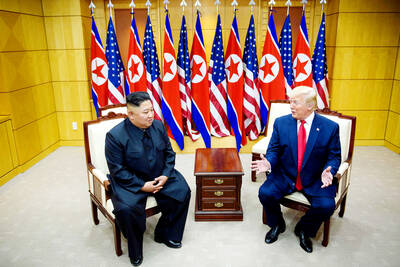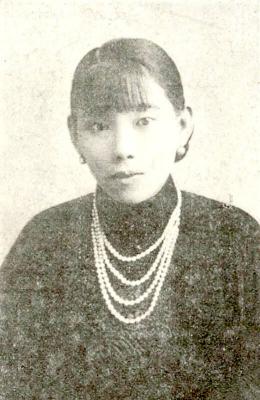El Toro, which opened near Yongchun (永春) MRT Station in late 2007, updates traditional Spanish cuisine with molecular gastronomy. The resume of the restaurant’s chef,
Daniel Negreira Bercero, includes a stint at El Bulli, the restaurant in Catalonia that is regarded as one of the foremost innovators in molecular gastronomy.
But what exactly is molecular gastronomy, which to uninitiated ears sounds more like a science experiment than a gourmet treat? “The point of molecular gastronomy is to keep the original taste of the ingredient, but change the shape and create something new,” explains Bercero.
Because the textures and colors (foam is one trademark) created by molecular gastronomy cooking techniques are novel to many diners, Bercero suggests that first-timers at El Toro let him customize a menu based on their budget and food preferences. We set a price of NT$1,500 per person and received nine courses, including dessert.
Molecular gastronomy is highlighted in the strawberry “caviar” that floated on top of the glass of chilled almond soup that kicked off our meal. This traditional Spanish dish is usually topped with grapes. El Toro swaps those for the sweet spheres, created by slowly dripping strawberry juice into an acid, which causes a thin membrane to form around each drop of liquid. The caviar felt smooth against our tongues before we popped them and added a dash of fruitiness to the creamy soup.
Our second dish consisted of a seared mussel on a base made out of ground kiwi that had been mixed with vodka and protein and sliced into a small round. Garnishes included a honey vinaigrette made with red onion and black olives, a sprig of dried guava, and foam created from a mixture of water taken from the mussel when it was opened and Curacao liquor, which lent its taste and a hint of blue to the dish. We were told to eat the whole thing at once, which allowed us to enjoy the tartness of the kiwi slice against the mellow sweetness of the mussel.
The following dish was a grilled octopus tentacle served with a glass test tube filled with a sauce that was made from a reduction of juice from the octopus meat. The meat itself was grilled very well: tender without being chewy.
The second soup of our meal was also made with cream, but this time flavored with clam broth. The soup was served separately for us to pour over three plump clams and a dollop of sea urchin.
Our next dish was a slice of salmon belly that had been slowly seared so that the fat of the salmon melted but stayed trapped within the skin. On a visual level, it looked very simple next to the more intricate dishes, but the taste was also novel. The fish was garnished with an unexpectedly sweet and complex mustard freshly prepared from mustard seeds, vinegar, Angostura bitters, parsley, honey, garlic and olive oil.
Seafood dominated our customized menu, but El Toro’s pork offerings are also noteworthy. Our meal was rounded out by a slice of foie gras wrapped in slow-cooked, tender pig ear, and two servings of sausage, including a very piquant slice of chorizo and a buttery piece of blood sausage. Despite the restaurant’s gourmet pedigree, the atmosphere is decidedly casual. We visited on a Saturday evening and while the staff was busy and somewhat rushed, Bercero made a point of being on hand to answer diners’ questions about his food and cooking methods. Weekday nights might be better for diners who want a more detailed explanation of how their dishes are prepared.

Many people noticed the flood of pro-China propaganda across a number of venues in recent weeks that looks like a coordinated assault on US Taiwan policy. It does look like an effort intended to influence the US before the meeting between US President Donald Trump and Chinese dictator Xi Jinping (習近平) over the weekend. Jennifer Kavanagh’s piece in the New York Times in September appears to be the opening strike of the current campaign. She followed up last week in the Lowy Interpreter, blaming the US for causing the PRC to escalate in the Philippines and Taiwan, saying that as

US President Donald Trump may have hoped for an impromptu talk with his old friend Kim Jong-un during a recent trip to Asia, but analysts say the increasingly emboldened North Korean despot had few good reasons to join the photo-op. Trump sent repeated overtures to Kim during his barnstorming tour of Asia, saying he was “100 percent” open to a meeting and even bucking decades of US policy by conceding that North Korea was “sort of a nuclear power.” But Pyongyang kept mum on the invitation, instead firing off missiles and sending its foreign minister to Russia and Belarus, with whom it

The Chinese Communist Party (CCP) has a dystopian, radical and dangerous conception of itself. Few are aware of this very fundamental difference between how they view power and how the rest of the world does. Even those of us who have lived in China sometimes fall back into the trap of viewing it through the lens of the power relationships common throughout the rest of the world, instead of understanding the CCP as it conceives of itself. Broadly speaking, the concepts of the people, race, culture, civilization, nation, government and religion are separate, though often overlapping and intertwined. A government

Nov. 3 to Nov. 9 In 1925, 18-year-old Huang Chin-chuan (黃金川) penned the following words: “When will the day of women’s equal rights arrive, so that my talents won’t drift away in the eastern stream?” These were the closing lines to her poem “Female Student” (女學生), which expressed her unwillingness to be confined to traditional female roles and her desire to study and explore the world. Born to a wealthy family on Nov. 5, 1907, Huang was able to study in Japan — a rare privilege for women in her time — and even made a name for herself in the